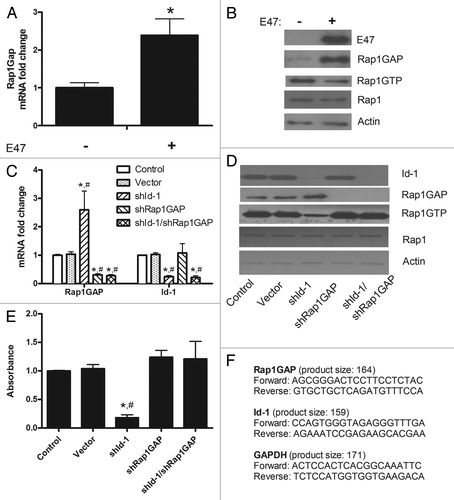Figures & data
Figure 1. (A) In primary cultured mNSC, Rap1GAP mRNA levels increase in presence of purified E47 protein. The expression levels were analyzed by real time RT-PCR (Applied Biosystems). The average of three independent analyses for each gene and sample was calculated and was normalized to the endogenous reference control gene GAPDH. Data are expressed as mean ± SE; *, p < 0.05, ANOVA. (B) E47 induces also an increase in Rap1GAP protein levels, assessed by a specific monoclonal antibody (Abcam), accompanied by a decrease in Rap1 activity, which was assayed using a pull-down assay (Thermo Fisher Scientific) in which isolation of Rap1-GTP was followed by western blotting and probing with an anti-Rap1 antibody (Thermo Fisher Scientific), according to the manufacturer’s instructions. Actin was used as loading control. Standard methods were used for immunoblotting. The blots shown are representative of three experiments. (C) Rap1GAP and Id-1 mRNA levels were assessed in mNSC as described in panel (A) after specific knockdown of Id-1, Rap1GAP or both (data are expressed as mean ± SE; *p < 0.01 vs. control; #, p < 0.01 vs. vector, ANOVA). (D) The expression levels of Id-1 and Rap1GAP and Rap1 activity were evaluated in mNSC after silencing of Id-1, Rap1GAP or both. Actin was used as loading control. Representative blots (performed in triplicate) are shown. (E) The cell adhesion assay was performed in quadruplicate using a commercially available kit (ScienCellTM) according to the manufacturer’s instructions (data are expressed as mean ± SE; *, p < 0.01 vs. control; #, p < 0.01 vs. vector, ANOVA). (C–E) Lentiviral vector-expressed shRNA sequences were CATGAACGGCTGTTACTCA for Id-1 and TTGGTGTGTGAAGACGTCA for Rap1GAP. (F) Sequences (5′-3′) and product length of the primers used to perform real time RT-PCR of Rap1GAP, Id-1 and GAPDH.
